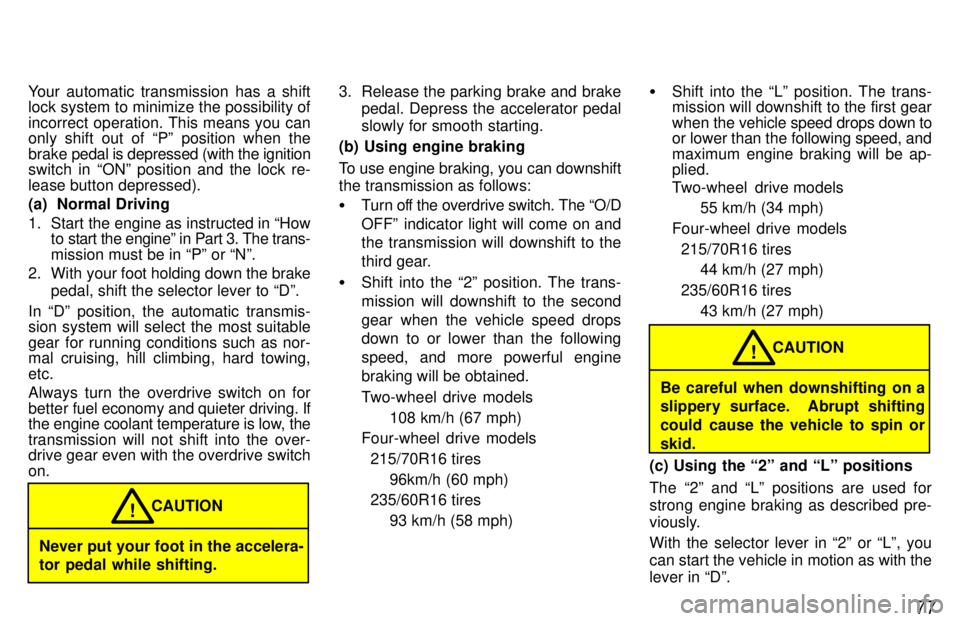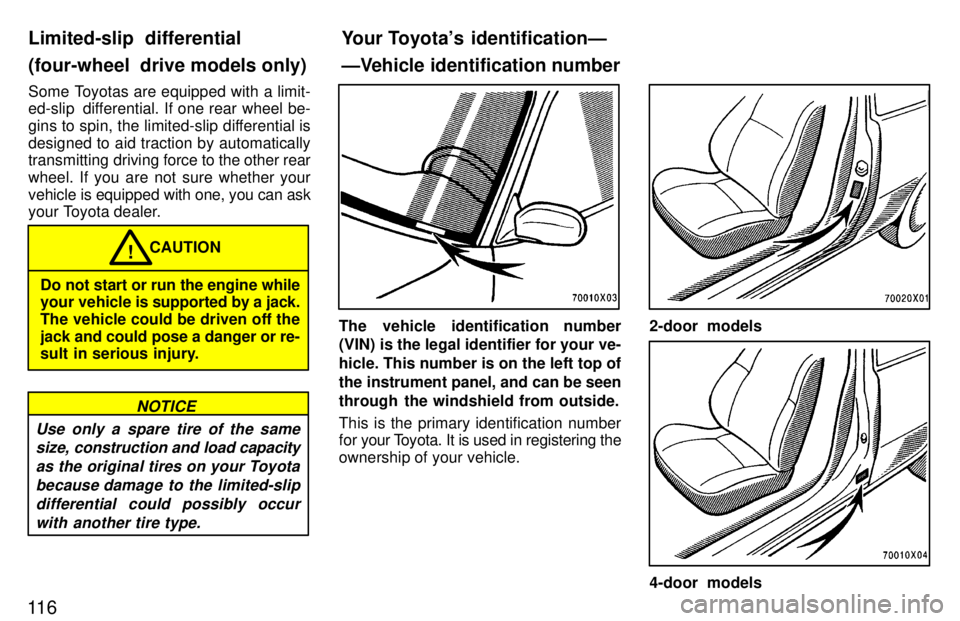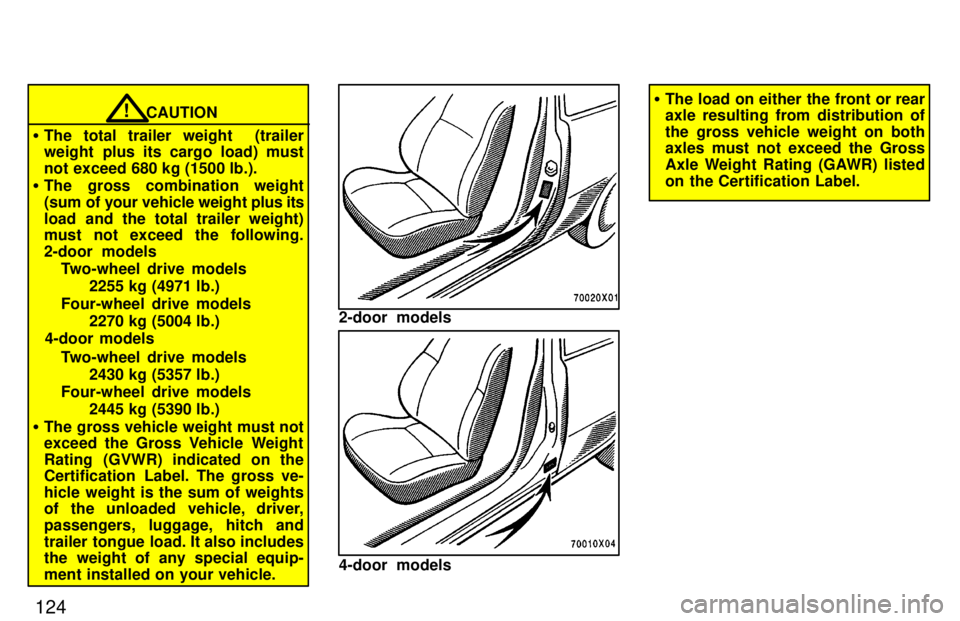1997 TOYOTA RAV4 four wheel drive
[x] Cancel search: four wheel drivePage 75 of 198

73
NOTICE
Do not continue driving if the engine drive belt is broken or loose.
(d) Low Oil Pressure Warning Light
This light warns that the engine oil pres-
sure is too low.
If it flickers or stays on while you are driv-
ing, pull off the road to a safe place and
stop the engine immediately. Call a Toyo-
ta dealer or qualified repair shop for assis-tance.
The light may occasionally flicker when
the engine is idling or it may come on brief-
ly after a hard stop. There is no cause for concern if it then goes out when the en-
gine is accelerated slightly.
The light may come on when the oil level
is extremely low. It is not designed to indi- cate low oil level, and the oil level must bechecked using the level dipstick.
Do not drive the vehicle with the
warning light onÐeven for one
block. It may ruin the engine. CAUTION
! (e) Malfunction Indicator Lamp
This lamp comes on in the following cases.
a. The fuel tank is completely empty. (See Fuel gaugeº in Chapter 1-5 for in- structions.)
b. The fuel tank cap is not tightened se-
curely. (See Fuel tank capº in Chapter
1-2 for instructions.)
c. There is a problem somewhere in your
engine or automatic transmission electri- cal system.
If it comes on while you are driving in case
c, have your vehicle checked/repaired by
your Toyota dealer as soon as possible.
(f) Low Fuel Level Warning Light
This light comes on when the fuel level in
the tank becomes nearly empty. Fill up the tank as soon as possible.
On inclines or curves, due to the move-
ment of fuel in the tank, the low fuel level
warning light may come on earlier than usual.
(g) ABSº Warning Light
This light warns that there is a problem
somewhere in your anti-lock brake sys- tem. If the light comes on while you are driving,
have your vehicle checked by your T
oyota
dealer as soon as possible.
The light will come on when the ignition
key is turned to the ONº position. After
about 3 seconds, the light will go off. When the ABSº warning light is on (and
the brake system warning light is off), the brake system operates conventionally but
anti-lock brake system is not assisting brake performance so that the wheels can
lock-up during sudden braking or braking
on slippery road surfaces.
(h) Open Door Warning Light
This light remains on until all the doors
and back door are completely closed.
(i) Automatic Transmission Fluid Tem-
perature Warning Light (four-
wheel drive models)
This light warns that the automatic trans- mission fluid temperature is too high.
Page 79 of 198

77
Your automatic transmission has a shift
lock system to minimize the possibility of
incorrect operation. This means you can
only shift out of Pº position when the brake
pedal is depressed (with the ignition
switch in ONº position and the lock re-
lease button depressed). (a) Normal Driving
1. Start the engine as instructed in How to start the engineº in Part 3. The trans- mission must be in Pº or Nº.
2. With your foot holding down the brake pedal, shift the selector lever to Dº.
In Dº position, the automatic transmis-
sion system will select the most suitable
gear for running conditions such as nor-
mal cruising, hill climbing, hard towing, etc.
Always turn the overdrive switch on for
better fuel economy and quieter driving. If
the engine coolant temperature is low, thetransmission will not shift into the over-
drive gear even with the overdrive switch on.
Never put your foot in the accelera- tor pedal while shifting. CAUTION
! 3. Release the parking brake and brake
pedal. Depress the accelerator pedal
slowly for smooth starting.
(b) Using engine braking
To use engine braking, you can downshift the transmission as follows: � Turn off the overdrive switch. The O/D
OFFº indicator light will come on and the transmission will downshift to the
third gear.
� Shift into the 2º position. The trans-
mission will downshift to the second
gear when the vehicle speed drops down to or lower than the following speed, and more powerful engine
braking will be obtained.
Two-wheel drive models
108 km/h (67 mph)
Four-wheel drive models 215/70R16 tires
96km/h (60 mph)
235/60R16 tires
93 km/h (58 mph) �
Shift into the Lº position. The trans- mission will downshift to the first gear
when the vehicle speed drops down to
or lower than the following speed, and
maximum engine braking will be ap- plied.
Two-wheel drive models
55 km/h (34 mph)
Four-wheel drive models 215/70R16 tires 44 km/h (27 mph)
235/60R16 tires 43 km/h (27 mph)
Be careful when downshifting on a
slippery surface. Abrupt shifting
could cause the vehicle to spin orskid. CAUTION
!
(c) Using the 2º and Lº positions
The 2º and Lº positions are used for
strong engine braking as described pre-
viously. With the selector lever in 2º or Lº, you
can start the vehicle in motion as with the
lever in Dº.
Page 80 of 198

78With the selector lever in 2º, the vehicle
will
start in the first gear and automatically
shift to the second gear.
With the selector lever in Lº, the trans-
mission is engaged in the first gear.
NOTICE
�Be careful not to overrev the en-
gine. Watch the tachometer to
keep engine rpm from going intothe red zone. The approximatemaximum allowable speed for
each position is given below foryour reference:Two-wheel drive models
2º 130 km/h (80 mph). . . . . .
Lº 72 km/h (44 mph) . . . . .
Four-wheel drive models
215/70R16 tires 2º 121 km/h (75 mph). . . . . .
Lº 67 km/h (41 mph) . . . . .
235/60R16 tires 2º 188 km/h (73 mph). . . . . .
Lº 65 km/h (40 mph) . . . . .
�Do not continue hill climbing or
hard towing for a long time in the
2º or Lº position. This may
cause severe automatic transmis-sion damage from overheating.
To prevent such damage, Dºposition should be used in hillclimbing or hard towing.
(d) Backing up
1. Bring the vehicle to a complete stop.
2. With the brake pedal held down with your foot, shift the selector lever to the
Rº position.
NOTICE
Never shift into reverse while the vehicle is moving.
(e) Parking
1. Bring the vehicle to a complete stop.
2. Pull the parking brake lever up fully to securely apply the parking brake.
3. With the brake pedal pressed down, shift the selector lever to the Pº posi- tion.
While the vehicle is moving, never
attempt to move the selector lever
into Pº position under any circum-
stances. Serious mechanical dam-
age and loss of vehicle control mayresult. CAUTION
!
(f) Good driving practice � If the transmission is repeatedly up-
shifted and downshifted between third
gear and overdrive when climbing a
gentle slope, the overdrive switch
should be turned off. Be sure to turn the switch on immediately afterward.
� When towing a trailer, in order to main-
tain engine braking efficiency, do notuse overdrive.
Always keep your foot on the brake
pedal while stopped with the engine
running. This prevents the vehicle
from creeping. CAUTION
!
Page 82 of 198

80
The shift pattern is as shown above.
Press the clutch pedal down fully while
shifting, and then release it slowly. Do not
rest your foot on the pedal while driving, because it will cause clutch trouble. And do not use the clutch to hold the vehicle
when stopped on an uphill grade-use the
parking brake. Recommended shifting speeds
The transmission is fully synchronized
and upshifting or downshifting is easy.
For the best compromise between fuel
economy and vehicle performance, you
should upshift or downshift at the follow-
ing speeds: gear km/h (mph)
1 to 2 or 2 to 1 24 (15)
2 to 3 or 3 to 2 41 (25)
3 to 4 or 4 to 3 65 (40)
4 to 5 or 5 to 4 72 (45)
Downshift to the appropriate gear if accel-
eration is needed when you are cruising
below the above downshifting speeds.
Upshifting too soon or downshifting too late will cause lugging and, possibly, ping-
ing. Regularly revving the engine to maxi-
mum speed in each gear will cause exces-sive engine wear and high fuel consump- tion.
Maximum allowable speeds
To get on a highway or to pass slower traf- fic, maximum acceleration may be neces-
sary. Make sure you observe the following
maximum allowable speeds in each gear:
Two-wheel drive models
gear km/h (mph)
1 47 (29)
2 95 (59)
3 144 (89)
4 198 (114) Four-wheel drive models 215/60R16 tires
gear km/h (mph)
1 44 (27)
2 88 (53)
3 133 (83)
4 183 (114)
235/60R16 tires
gear km/h (mph)
1 43 (26)
2 86 (53)
3 121 (75)
4 165 (102)
NOTICE
Do not downshift if you are going faster than the maximum allowable
speed for the next lower gear.
Good driving practice � If it is difficult to shift into reverse, put
the transmission in neutral, release
the clutch pedal momentarily, and then
try again.
Manual transmission
Page 83 of 198

81
�
When towing a trailer, in order to main-
tain engine braking efficiency, do not
use the fifth gear.
Be careful when downshifting on a
slippery surface. Abrupt shifting
could cause the vehicle to spin orskid. CAUTION
!
NOTICE
Make sure the vehicle is completely stopped before shifting into
reverse.
The center differential lock system is pro-
vided for use only when the vehicle does not have enough traction to move itself out of the following situations. � All front wheels or rear wheels are off the ground or on a slippery surface.
� One of the four wheels is off the ground or on a slippery surface.
Operating precautions � If the front wheels and rear wheels are
worn unevenly, the center differential
may not lock or unlock smoothly.
� Before locking the center differential,
make sure the wheels have stopped spinning. �
Unlock the center differential immedi-
ately after you finish using the center
differential lock system. An indicatorbuzzer will sound while the center dif-ferential is being unlocked.
� After you have pushed the center dif-ferential lock switch to lock and moved
the vehicle a short distance, the indi-
cator light in the instrument panel
stays on. If the light either fails to come
on or goes out, ask your Toyota dealer
to check the electrical system and the
locking mechanism.
The center differential must be un- locked in normal driving. Locking the center differential will result in
difficult cornering control. CAUTION
!
NOTICE
Do not drive on a dry paved surface with the center differential locked.
This may damage the lockingmechanism and the drive system.
Center differential lock system (four-wheel drive models with manual transmission)
Page 117 of 198

11 6Some Toyotas are equipped with a limit-
ed-slip differential. If one rear wheel be-
gins to spin, the limited-slip differential is
designed to aid traction by automatically
transmitting driving force to the other rear
wheel. If you are not sure whether your
vehicle is equipped
with one, you can ask
your Toyota dealer.
CAUTION!
Do not start or run the engine while
your vehicle is supported by a jack.
The vehicle could be driven off the jack and could pose a danger or re-
sult in serious injury.
Use only a spare tire of the same
size, construction and load capacity
as the original tires on your Toyota because damage to the limited-slip differential could possibly occurwith another tire type.
NOTICE
The vehicle identification number
(VIN) is the legal identifier for your ve- hicle. This number is on the left top of
the instrument panel, and can be seen
through the windshield from outside.
This is the primary identification number
for your T oyota. It is used in registering the
ownership of your vehicle.2-door models
4-door models
Limited-slip differential
(four-wheel drive models only)
Your Toyota's identificationÐ
ÐVehicle identification number
Page 125 of 198

124
CAUTION!
� The total trailer weight (trailer
weight plus its cargo load) must
not exceed 680 kg (1500 lb.).
� The gross combination weight
(sum of your vehicle weight plus its
load and the total trailer weight)
must not exceed the following.
2-door models
Two-wheel drive models
2255 kg (4971 lb.)
Four-wheel drive models 2270 kg (5004 lb.)
4-door models
Two-wheel drive models2430 kg (5357 lb.)
Four-wheel drive models 2445 kg (5390 lb.)
� The gross vehicle weight must not
exceed the Gross Vehicle Weight
Rating (GVWR) indicated on the
Certification Label. The gross ve-
hicle weight is the sum of weights
of the unloaded vehicle, driver,
passengers, luggage, hitch and
trailer tongue load. It also includes
the weight of any special equip-
ment installed on your vehicle.
2-door models
4-door models
�The load on either the front or rear axle resulting from distribution of
the gross vehicle weight on both axles must not exceed the Gross
Axle Weight Rating (GAWR) listed
on the Certification Label.
Page 143 of 198

143
Two-wheel drive modelsFour-wheel drive modelsIf towing is necessary, we recommend
you to have it done by your Toyota
dealer or a commercial tow truck ser-
vice. In consultation with them, have
your vehicle towed using either (a) or(b).
Only when you cannot receive a tow-
ing service from a Toyota dealer or
commercial tow truck service, tow
your vehicle carefully in accordance
with the instructions given in
ÐEmergency towingº in this part. Proper equipment will help ensure that your vehicle is not damaged while being
towed. Commercial operators are gener-
ally
aware of the state/provincial and local
laws pertaining to towing.
Your vehicle can be damaged if it is towed
incorrectly. Although most operators know the correct procedure, it is possible
to make a mistake. To avoid damage to your vehicle, make sure the following few
precautions are observed. If necessary,
show this page to the tow truck driver.
If your vehicle needs to be towedÐ